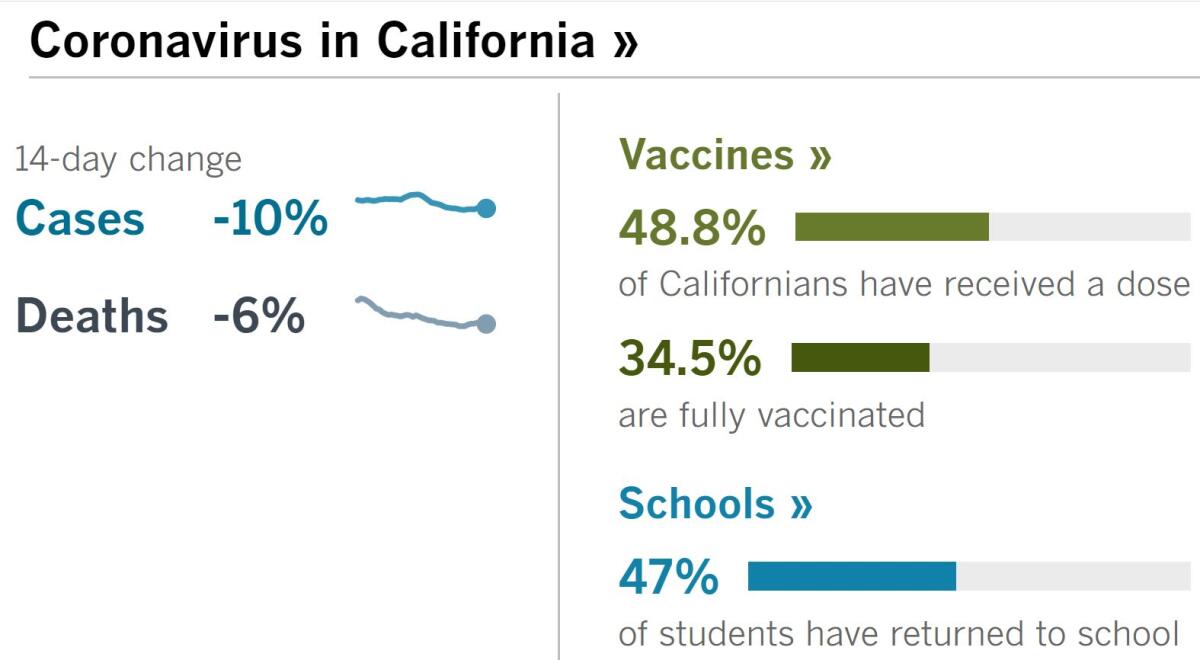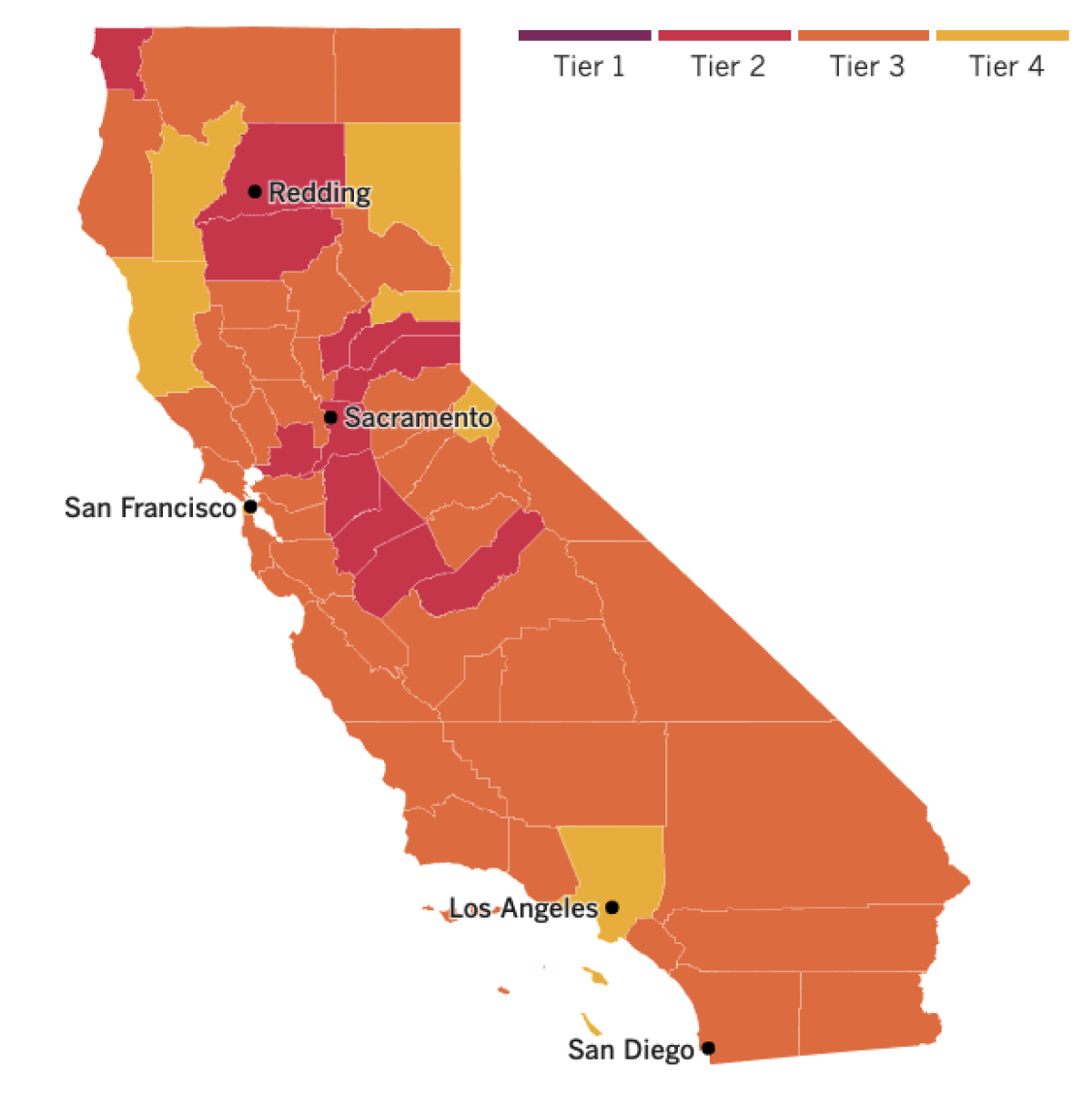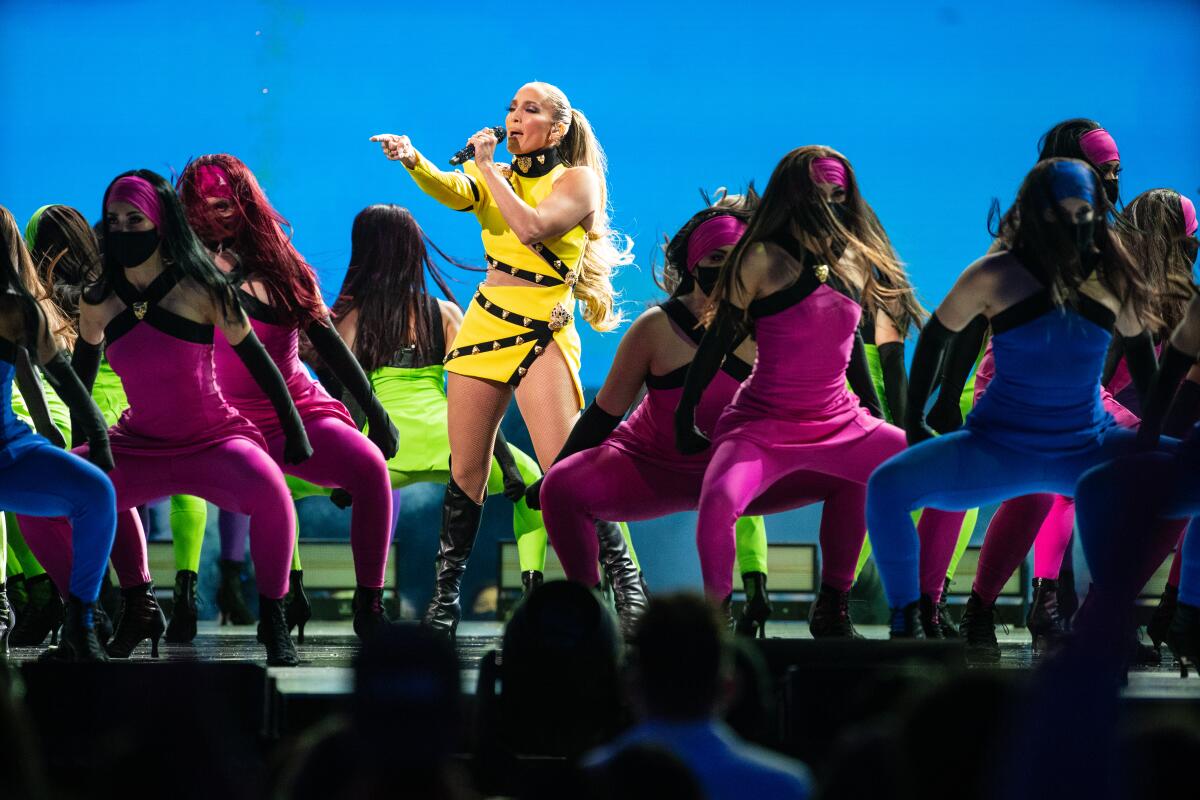Coronavirus Today: Pomp and a bad circumstance
- Share via
Good evening. I’m Thuc Nhi Nguyen, and it’s Friday, May 7. Here’s the latest on what’s happening with the coronavirus, plus ways to spend your weekend and a look at some of the week’s best stories.
Last month, Cal State L.A. announced plans for a graduation ceremony at the Rose Bowl. It was going to have all the classics for the classes of 2020 and 2021: speeches, music and jumbotron close-ups.
This week, the school clarified the fine print: no guests, no names read aloud, no walking on the stage.
So much outrage followed that university officials canceled the event altogether. Back to Zoom it is.
While planning much-anticipated commencement ceremonies, many colleges are trying to balance public health protocols and old traditions, but they’re tripping with every step across the stage, my colleague Nina Agrawal reports.
Students who are the first in their families to graduate from college were hoping to share the experience with relatives. Caps and gowns were ordered, and calendars were marked. One Cal State L.A. student wrote on Instagram that her mother was planning to fly from Nicaragua for the event.
Even Caltech, a bastion of brainiacs with only about 240 graduating seniors to worry about, can’t find the right combination. The university’s initial plans for a virtual ceremony were met by a student petition for in-person festivities. The follow-up offer of letting students gather on campus for a screening of the virtual ceremony didn’t make the grade.
“It feels like a slap in the face,” said Nayla Abney, a Caltech student who led the petition drive.
But Shayna Chabner, Caltech’s chief communications officer, said a virtual ceremony in June and an in-person event in the fall would allow for “timely and equitable” celebrations for the university’s international community.
More vaccinations fueled hopes for large-scale events, but health officials are now contending with dwindling demand for shots. They’ve already announced plans to tweak their strategy and step up efforts to address specific communities that may be reluctant to roll up their sleeves.
Among them are young Black and Latino people, who have the lowest COVID-19 vaccination rate of any other age, racial and ethnic group in Los Angeles County, my colleagues Hayley Smith and Rong-Gong Lin II report. The vaccination disparities leave communities that have already suffered the most from COVID-19 at risk for further heartbreak.
Only 18% of Black men and 20% of Black women ages 16 to 29 have received at least one dose of the vaccine, according to county data. Within the Latino community, 24% of men and 31% of women of the same age group have had at least one dose.
By comparison, 43% of white men and 51% of white women 16 to 29 have received a dose, as have 57% of Asian American men and 65% of Asian American women, and 43% of Native American men and 53% of Native American women.
Meanwhile in India, the devastation wrought by the latest coronavirus outbreak is being felt across all demographic groups, my colleagues on the foreign desk report.
After ravaging the poor last year, COVID-19 is now taking its toll on the country’s middle and upper classes. No one is exempt. Politicians, cricket players and Bollywood stars such as Deepika Padukone, one of India’s most popular actresses, have all contracted the virus.
High-rise apartments, which only Indians with means can afford, have become transmission spots because of their central air conditioning systems and elevators. To make matters worse, the government said this week that a third wave is “inevitable.”
The crisis in India, home to the world’s largest vaccine manufacturer, has exacerbated the global shortage of COVID-19 vaccine. India was expected to supply millions of doses for developing countries but stopped exporting shots while trying to deal with the outbreak at home.
A vaccine developed in China could help fill the need after the World Health Organization gave emergency use authorization to a shot from Sinopharm on Friday. The vaccine, the first from a non-Western country to earn WHO authorization, can now be included in the U.N.-backed COVAX program and distributed to needy countries.
Sinopharm hasn’t released much information about the efficacy of its shots, so the WHO requested a breakdown of its data. A group advising the WHO said it was “very confident” the Sinopharm vaccine protects people ages 18 to 59. But because of insufficient data, the group said it had a “low level of confidence” in the vaccine’s efficacy for people 60 and older and “very low confidence” in the available data about serious side effects in that age group.
By the numbers
California cases, deaths and vaccinations as of 6:31 p.m. Friday:

Track California’s coronavirus spread and vaccination efforts — including the latest numbers and how they break down — with our graphics.

See the current status of California’s reopening, county by county, with our tracker.


What to read this weekend
Back to school
The first-day-of-school outfit is an all-important decision for many students. It’s an even bigger deal if you haven’t put on anything but sweatpants for more than a year.
With high school campuses reopening across L.A. County, students are redefining their back-to-school wardrobes, my colleague Sonja Sharp reports.
Take 17-year-old Sheccid Vazquez. The Ramona Convent Secondary School senior kept it laid-back with pajamas during her remote-learning classes. Even before the pandemic, she stayed casual with jeans and a T-shirt, but she returned to campus with a vintage crop tank top.
“My style right now would be ’90s but modernized,” Sheccid said. “I’ve been looking more toward thrift stores and secondhand shops, a lot of vintage things.”
Secondhand stores are fashion goldmines for kids these days, who are focused on sustainability and also want to bring back trends from the 1990s and early 2000s. That means baggy jeans, oversized T-shirts and flashy shoes. And don’t forget the masks.

Level up
Video games used to be thought to turn brains to mush. They were eyed as the cause of so many things ailing American youth. They pulled kids away from other family members.
Not anymore.
In fact, video games helped bring my colleague Deborah Netburn and her 12-year-old son closer during the pandemic, she writes.
Many children have devoted even more time to video games during the last year, and while that may alarm parents, experts say there’s no reason for concern. It’s the natural extension of old family games such as Go Fish or playing catch.
“Kids learn through play as part of their way of connecting to the world,” said Sinem Siyahhan, a professor of educational technology at Cal State San Marcos. “What happens over time is your play experience evolves. I see video games as a part of this evolution.”
There’s no pandemic in their virtual worlds when kids log in. Their friends are there, unlike IRL — “in real life” for those still learning. Indeed, for Netburn’s son, online games are “pretty much the only thing that makes me happy right now.”
When his mom grabbed a controller too, it made him even happier.

Inside the used-car boom
If you’ve got a used car sitting in your driveway, you could be looking at a big pay day.
There’s never been a better time to sell a used car as demand outpaces the pandemic-suffocated supply, my colleague Daniel Miller reports.
The average list price for a used car in the Los Angeles region early last month was $22,963. That’s a 12% increase from 2020 and 14% higher than in 2019.
A number of factors are contributing to the red-hot used-car market. The biggest is a slower influx of cars from rental car companies that used to send older rides to lots to be sold. The pandemic completely halted the rental car business, and companies stopped buying new cars while also unloading huge portions of their existing fleets.
Now that people are ready to get out of the house, they’re also looking to buy a new ride, perhaps with their stimulus checks, but the manufacturing of new cars has slowed down. So shoppers are turning to used cars instead.
Add it all up, and even an inoperable 2008 Mazda Tribute garnered $800 and more than 30 inquiries on Facebook.
The ‘shecession’
A few months ago, when we marked the one-year anniversary of the pandemic, my colleagues wrote that we have all suffered during the last year, but we have not all suffered equally. I’m still thinking about that now.
One area of inequity is the workplace. During the last year, 12% of women have lost jobs statewide, compared with 10.4% of men. Economists call it the “shecession” as the pandemic forced working women to make tough choices about their families, their health and their jobs, my colleague Margot Roosevelt reports.
Coronavirus closures were acutely felt in service occupations that women tend to hold, such as hairdressing and housekeeping.
That’s where Alejandra Siciliano once worked as a hotel housekeeper. She was terrified that she would contract the coronavirus while working, but after getting laid off in March, she prays for any job to catch up with mounting bills.
Siciliano’s savings, along with government stimulus checks, sustained her family, which includes her disabled husband, her daughter, her son-in-law and her granddaughter. Food stamps helped stave off hunger, along with visits to evangelical churches where she would wait as long as four hours to get beans, chicken and canned fruit. But she still owes $4,000 in back rent and fears eviction from her family’s South Gate apartment.
Thousands of other women in California are facing similar struggles.

Still fighting
Dr. Nadine Burke Harris described the last year as “heartbreak on top of heartbreak.” But the low point of the pandemic for California’s surgeon general happened well before the state’s death toll topped 60,000.
It came last spring, when she and her colleagues were scrambling to set up contact tracing, COVID-19 tests and data projections. Meanwhile, then-President Trump was promising an open economy by Easter. Burke Harris knew it was impossible.
“I went into the bathroom, and I sobbed,” Burke Harris said. “I felt like we were all working so incredibly hard, and then there was this other narrative out there that just didn’t have any foundation in reality or science or data, and it only was making our job harder.”
After being named California’s first surgeon general in 2019, Burke Harris has already spent half of her term navigating the COVID-19 pandemic, my colleague Marissa Evans reports. Becoming one of the nation’s most influential public health figures has been stressful for the Jamaican American pediatrician, but she’s not backing down, even when health inequities seem so pervasive that others may believe they’re insurmountable.
“We’re going to put our back into it and use our full force and weight to push against these inequities,” Burke Harris said.

Shots and tacos
Tacos and tequila already make an iconic pairing, but Rida Hamida is adding a different kind of shot.
The Anaheim activist is bringing taco trucks to Orange County mosques and including a dose of Pfizer-BioNTech’s COVID-19 vaccine for people in communities who may not know how to get it otherwise, columnist Gustavo Arellano writes.
Hamida, a longtime presence in Orange County’s progressive scene, started Taco Trucks at Every Mosque in 2017. It combines cultural touchstones for two maligned groups who can meet, learn about each other and work toward political change. Previous activism efforts included voter registration drives and a push to fill out U.S. census forms. This year, it’s vaccines, inspired by Muslim women at her Pilates class who confessed they had no idea how to sign up for an appointment.
Care Ambulance Service brought 150 shots to a pop-up clinic at the Islamic Center of Santa Ana and will do so again Saturday at the West Coast Islamic Society in Anaheim.
“She’s a total patrona,” or boss lady, said Moises Moreno, the taquero who caters Hamida’s Orange County events. “Rida is one of those people who doesn’t just say stuff to say stuff. She does stuff.”

Busted
We should have known this was coming.
With the debate about “vaccine passports” raging, people faking documents that may be required to gain access to events seemed inevitable. After all, the simple white vaccination record card looks like something you could easily reproduce from your own laser printer.
The owner of a San Joaquin County bar is accused of trying that. He’s now in deep trouble, my colleague Hayley Smith reports.
Todd Anderson was caught selling fraudulent vaccination cards at his bar, authorities say. He faces three felony counts, including forgery of a government seal, identity theft and having an unregistered firearm in a public place. He’s also charged with a misdemeanor count of falsifying medical records.
Undercover agents purchased four fake cards for $20 each at the Old Corner Saloon in Clements after the California Department of Alcoholic Beverage Control received complaints about the phony cards.
“Where there’s an opportunity and a need, people fill it,” said Elisa Bubak, a spokeswoman for the San Joaquin County district attorney’s office.
Your support helps us deliver the news that matters most.
What to do this weekend
Get outside. Upgrade your basic Mother’s Day brunch to a hike-and-picnic combo with one of these six ideal trails. Or visit an installation for “Art Rise,” a series of 21 projects created by local artists to highlight the healing power of art across five neighborhoods. Subscribe to the Wild for more on the outdoors and to Escapes for travel inspiration.
Watch something great. If you’re tired of watching movies at home, check out our rundown of movies playing on a big screen (indoors and outdoors) near you. This week, Hollywood’s El Capitan is playing “The Little Mermaid,” and the Roadium Drive-In in Torrance is showing “Cars.” And in his Indie Focus newsletter’s roundup of new movies, Mark Olsen highlights “The Disciple,” which features Aditya Modak as a young man in India studying to become a classical violinist.
Eat something great. Mix up a Bloody Mary for mom and let her unwind with Ben Mims’ take on the classic cocktail. Or pull out all the stops with 28 recipes for the full brunch experience, including passionfruit poppy seed muffins and chorizo migas. Subscribe to the Tasting Notes and Cooking newsletters for more.
Go online. Here’s The Times’ guide to the internet for when you’re looking for information on self-care, feel like learning something new or interesting, or want to expand your entertainment horizons.
The pandemic in pictures

Jennifer Lopez headlined the first large-scale live music event in Los Angeles since the start of the pandemic, performing in front of 20,000 people at the Vax Live concert at SoFi Stadium last weekend. Lopez performed in all her glamorous glory, rocking a jeweled, fluorescent yellow outfit with knee-high black boots while masked dancers backed her up.
The crowd was full of healthcare and other essential workers, all vaccinated. Acts included the Foo Fighters, Eddie Vedder and J Balvin with live guest appearances from Ben Affleck, Jimmy Kimmel, David Letterman, Sean Penn and Prince Harry.
“This night is the first taste of the life we’ve all been missing,” Penn said to much applause as he introduced his old pal Vedder, who struck an endearing note of disbelief between songs.
“Holy f—,” Vedder exclaimed. “There’s a microphone. There’s a crowd.”

Resources
Need a vaccine? Sign up for email updates, and make an appointment where you live: City of Los Angeles | Los Angeles County | Kern County | Orange County | Riverside County | San Bernardino County | San Diego County | San Luis Obispo County | Santa Barbara County | Ventura County
Need more vaccine help? Talk to your healthcare provider. Call the state’s COVID-19 hotline at (833) 422-4255. And consult our county-by-county guides to getting vaccinated.
Practice social distancing using these tips, and wear a mask or two.
Watch for symptoms such as fever, cough, shortness of breath, chills, shaking with chills, muscle pain, headache, sore throat and loss of taste or smell. Here’s what to look for and when.
Need to get tested? Here’s where you can in L.A. County and around California.
Americans are hurting in many ways. We have advice for helping kids cope, resources for people experiencing domestic abuse and a newsletter to help you make ends meet.
We’ve answered hundreds of readers’ questions. Explore them in our archive here.
For our most up-to-date coverage, visit our homepage and our Health section, get our breaking news alerts, and follow us on Twitter and Instagram.




